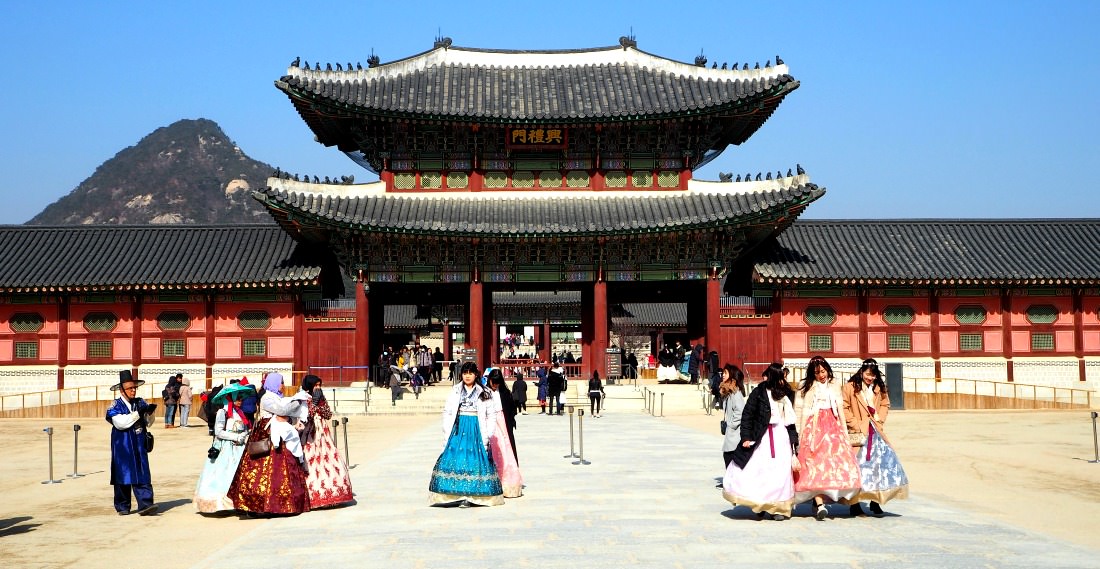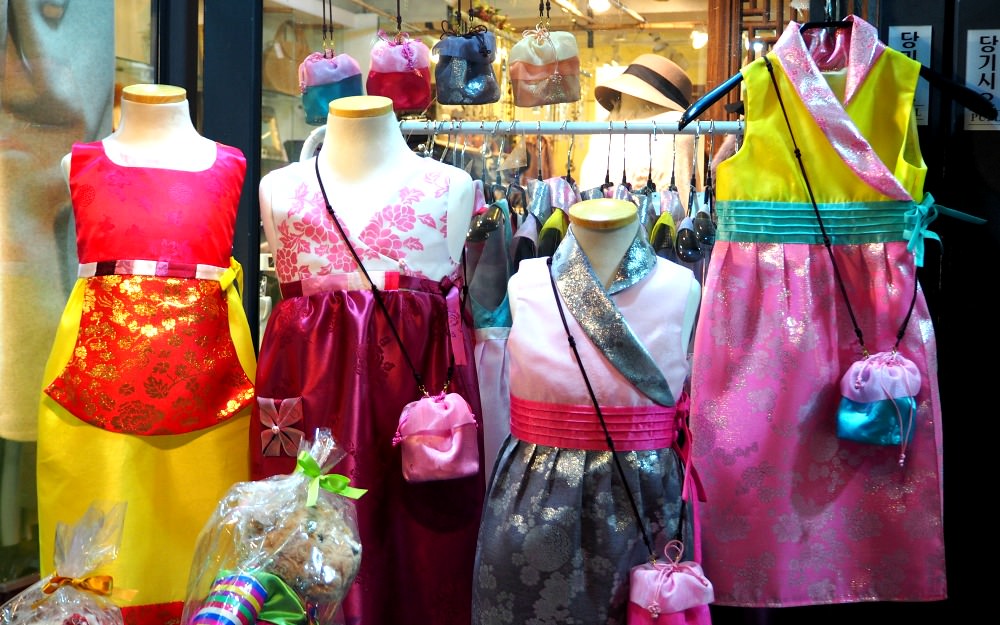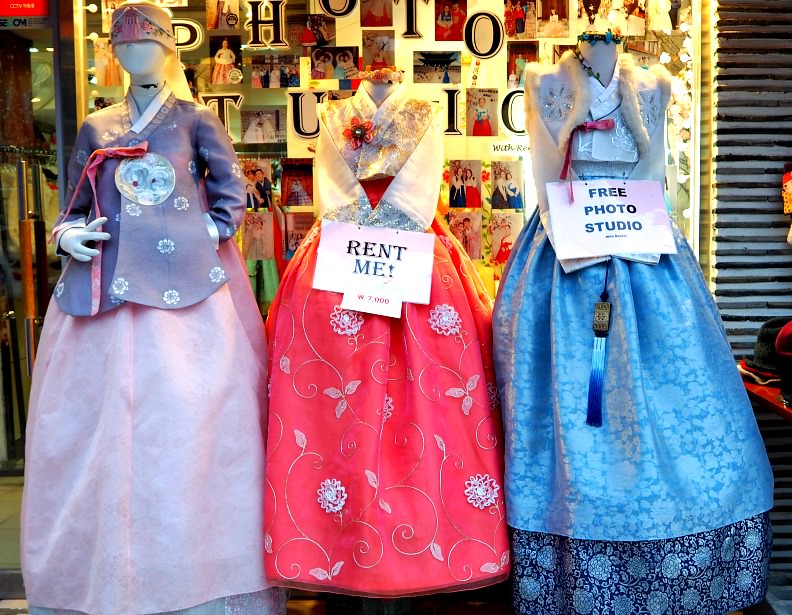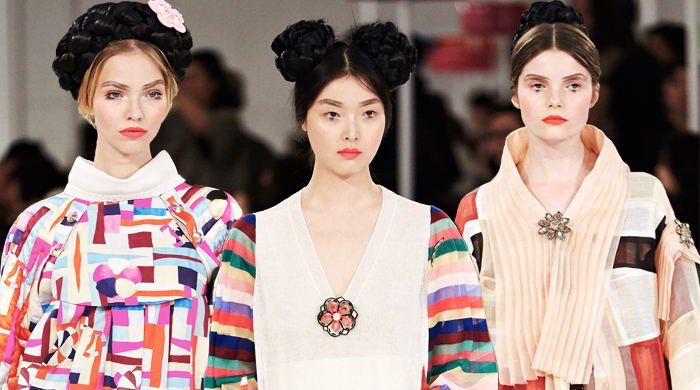Korean Clothing
 Men and women wearing their 'hanbok's during their visit at Gyeongbokgung Palace in Seoul
Men and women wearing their 'hanbok's during their visit at Gyeongbokgung Palace in SeoulKorean Clothing
Korean clothing culture and dressing fashion nowadays are advanced and highly modified. However advanced and trendy the Koreans maybe, you can still observe traditional aspects infused into the newly-discovered and ever-changing styles and trends.
This article basically outlines the origins and trends of Korean clothing in this Asian nation that competes with the recent development in clothing trends around the world.
Since the appearance of Korean people in ancient times on the land now called the Korean Peninsula, the Korean people have developed a wealth of unique cultural traditions connected to the method they dress, eat, and act.
These customs show the natural surroundings of their homeland, an environment predominately covered by hills and mountains, surrounded by the sea on three sides and marked by four distinct seasons.
All these factors have been influencing the lives, behavior, especially the way Korean people adapt to their surroundings with clothing culture and methods of producing them.
Korean Clothing Style
The Korean people have been using numerous materials, such as sambe (hemp), mosi (ramie), cotton, and silk, to manufacture clothing that is not only appealing but furthermore provides them with adequate protection even throughout the harshest winter seasons and the hottest summer seasons.
They make warm winter season clothing utilizing the method of filling soft cotton between two layers of silk, cotton or product fabric and stitching them together with fine stitching. And they produce cool summer clothes with hemp and ramie.
These clothing typically feature stylish lines and forms that create the serene aura characteristic of the traditional Korean clothes we know as 'hanbok' which literally means 'Korean clothing.'
Korea's indigenous clothing, hanbok, has actually preserved its traditional features throughout Korea's 5,000-year history.
While in the same manner, its forms and designs have actually evolved in various respects based on the way of life, social conditions, and aesthetic taste of the people at different periods in history.
 Hanbok for girls on display in Seoul
Hanbok for girls on display in Seoul Stylish and modified type of 'hanbok' avaialable for rent in Seoul
Stylish and modified type of 'hanbok' avaialable for rent in SeoulHistory reveals that Koreans in the past tended to fancy comfortable, white clothing to clothing decorated with different colors and designs.
Because of that practical but straightforward preference, they were frequently referred to as "the white-clad individuals."
On the other hand, Korea has likewise had a long tradition of taking pleasure in colorful clothing with intricate designs depending on the wearer and the wearer's social status.
Hanbok, the conventional clothing of Koreans
"Hanbok" (likewise called "joseon-ot") is a collective term for conventional Korean clothing. Though there have actually been minor modifications in hanbok gradually in terms of product, colors, and the length of the skirt or jacket, the hanbok's original design has more or less remained intact for the past 1,600 years.
Hanbok can be classified into a daily and ceremonial dress, each of which can be classified according to age, gender, season, or even occasion.
All types of hanbok are produced through combinations of somewhat curved and straight lines. Women's hanbok, in particular, is acknowledged worldwide for the essential and delightful consistency of their short capes and full skirts.
The cape, which is put on one arm at a time, makes the upper body look very slim, while the skirt curled around the waist makes the lower body appearance full and well-balanced.
The cut and drape of the clothing complement not only the Korean female body but also fits most other body types.
Today, Korea is home to many skilled designers who have actually made a global track record with their innovative styles. Their designs combine conventional Korean styles and patterns with a contemporary creative sensibility.
The appeal of standard Korean clothing has actually been introduced to many parts of the world. Thanks to the fantastic success over the last few years of many Korean movies and TV dramas, including Dae Jang Geum.
Koreans today seem to prefer clothes inspired by modern-day Western designs other than their traditional garments.
However, some individuals still insist on using the traditional and somewhat modified during holidays or for unique household occasions such as weddings, birthday, and gatherings.
 More aggressive designs of Hanbok are being used at international fashion shows (Chanel fashion show in Seoul)
More aggressive designs of Hanbok are being used at international fashion shows (Chanel fashion show in Seoul)Their endearment of tradition and yearning for the brand-new, in some cases, resulted in the production of appealing "up-to-date hanbok" with modifications to adapt to the new trends in clothing culture worldwide.
Gangnam-gu in Seoul is a big district where luxurious houses sit along with high-end art facilities and Korea's busiest fashion streets. Thanks to the "Gangnam Style" K-Pop song that shook that world in 2012. Gangnam is now a household name in the international world!
The district now brings in numerous fashion-minded travelers from across East Asia and beyond with annual style festivals consisting of global fashion shows and contests participated in by several rising fashion designers.
Another modern fashion district in Seoul that enjoys a worldwide reputation is Dongdaemun-gu (District), where the Dongdaemun Design Plaza is established.
Dongdaemun District is now transformed into a hub of the regional fashion industry, providing creative, economical fashion products for youth and the young at heart.
With its fully developed distribution and sales network, extremely efficient production facilities, and a throng of talented, ambitious designers, the district is now one of Seoul's most popular destinations amongst foreign tourists.
Get Exciting Activities
Book one of our exciting activities today to experience the thrill of a lifetime! Take advantage of this opportunity and secure your spot in advance.
Hotel Map Guide
Find your affordable, accessible, and comfortable hotel in Seoul at Agoda.Com. See the hotel map below...
Hotel Booking Guide
Find affordable and amazing hotels on Agoda.com using the search box below. Book now to enjoy great discounts and save!







New! Comments
What do you think about this page? Leave me a comment in the box below.